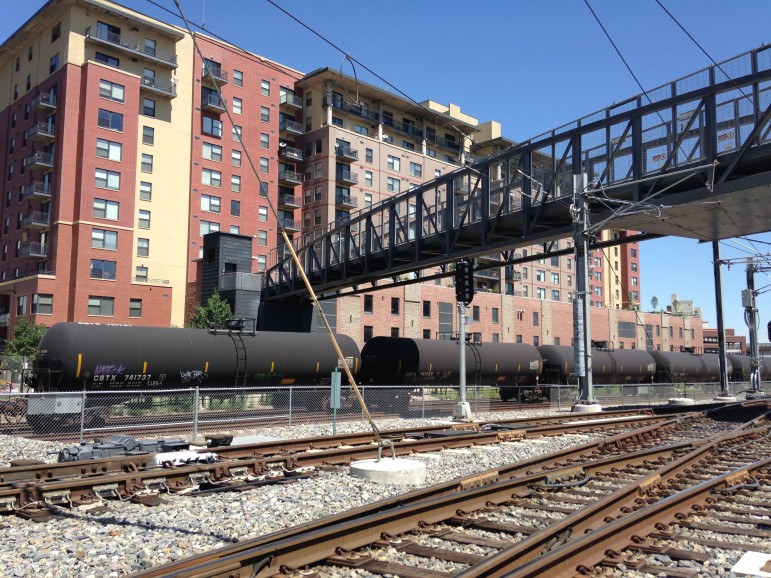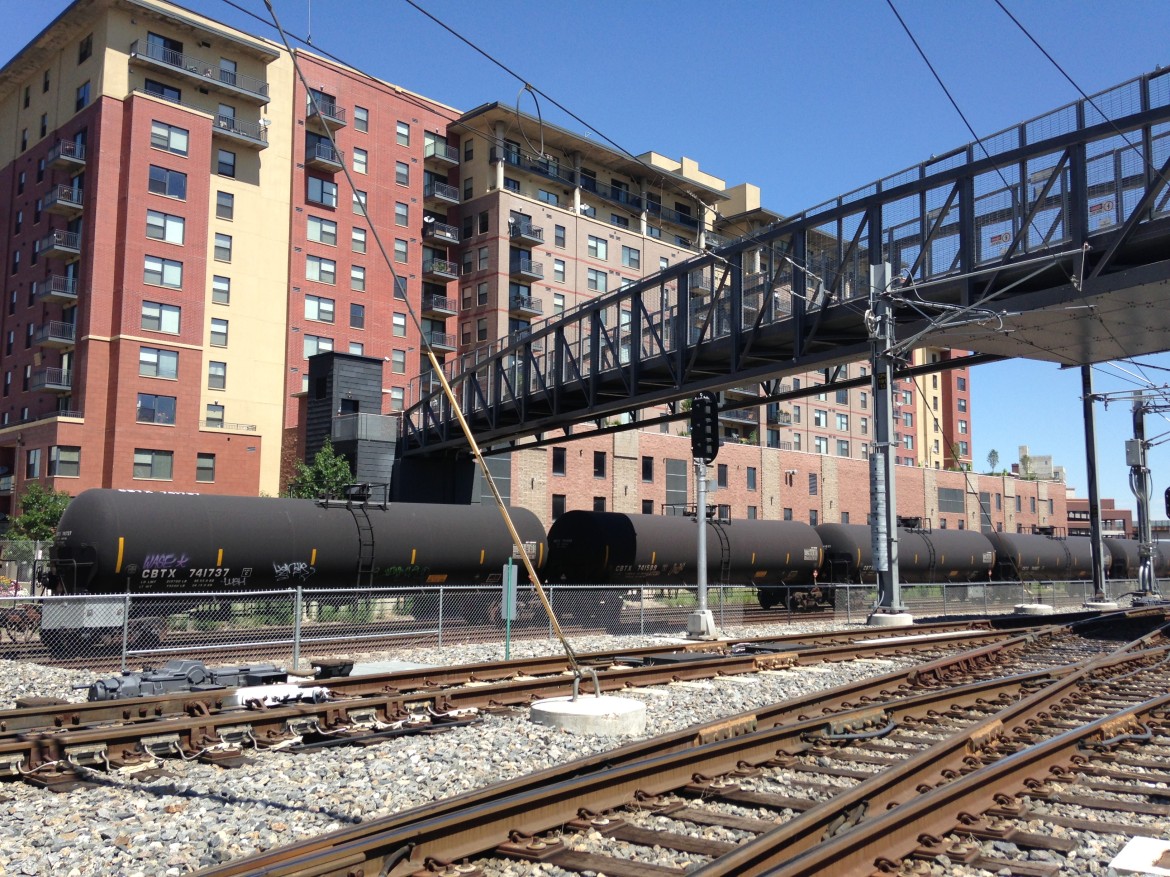
Photo by Jordan Wirfs-Brock.
Crude oil tankers sit on the track in Denver’s Lodo neighborhood.
The Associated Press reported last week that environmental groups are suing the U.S. Department of Transportation over the shipment of crude oil in older railroad tank cars. The lawsuit follows a series of arguments, complaints and regulation changes over the past few months regarding safety rules and industry secrecy, which Inside Energy investigated during the summer.
Crude by rail safety hinges on three issues: the train routes, which often go through populated areas; the integrity of the cars used to hold the oil; and the volatility of oil coming from the Bakken formation.
AP Reported:
The lawsuit filed by the Sierra Club and ForestEthics says the agency failed to respond to a legal petition the groups filed in July. That petition sought an emergency order to prohibit crude oil from the Bakken region of North Dakota and Montana and elsewhere from being carried in older tank cars, known as DOT-111s.
The transport of crude oil via rail has spiked in the past few years, turning the public’s attention to the safety implications. Jordan-Wirfs Brock analyzed and visualized data on the amount of crude being transported, accidents and spills , and waybills – which reveal information about train routes – to put the numbers into context.
The safety concerns have been spurred by a series of derailments that caused oil spills from ruptured tanks, the worst of which resulted in 47 deaths in Lac-Megantic, a town in Quebuec, in 2013.
In June, Stephanie Joyce reported on the secrecy keeping information on crude oil transportation from the public. BNSF and Union Pacific, the biggest railroads in the west, said the secrecy was due to safety and security reasons, a statement contradicted by the Federal Railroad Administration who said they had no problem with releasing the data to the public. Joyce reported:
The federal Department of Transportation recently ordered the railroads to share information with states about trains carrying over a million gallons of crude from the Bakken oil fields of North Dakota.
Later that month, Dan Boyce reported that the Governor of Montana released information on the routes of crude oil trains traveling from the Bakken region through the north of the state. Other states like Wyoming and Colorado have agreed not to publicly release the data beyond first responders and emergency planners.
But whether the route information is disclosed doesn’t change the fact that crude oil is mostly being transported in DOT-111 tank cars. That’s the main concern for the groups behind the lawsuit. As Joyce reported, the Department of Transportation released a set of proposed rules in July to address several issues related to crude oil transportation. The proposed rules would phase out the DOT-111 tanks over the next two years, but don’t specify what they would be replaced with.
That wasn’t enough to appease the environmental groups. AP reported:
But that process could take several years, and in the meantime, shipments of crude oil in older rail cars are putting small towns and major cities along the rail lines at risk, the groups said.
“That’s just far too long given the risks,” said Patti Goldman, a lawyer with Earthjustice, which is representing the groups.
More from Inside Energy on crude by rail
- “Railroads and Energy Companies Argue Over New Safety Proposals” by Jane Palmer
- “Crude Oil By Rail: On The Rise In Colorado And Everywhere” by Grace Hood
- “Crude-By-Rail Data Dive: One Rail Company Dominates” by Jordan Wirfs-Brock
- “Data-Dive: Crude-By-Rail’s Safety Record Depends On How You Count” by Jordan Wirfs-Brock
- “Train Waybills Unlock Crude Oil Mysteries” by Jordan Wirfs-Brock
- “Crude Oil Train Secrecy” by Stephanie Joyce
- “Montana Crude Rail Routes Revealed” by Dan Boyce
- “30,000 Gallons of Crude By Rail Every 77 Seconds” by Jordan Wirfs-Brock
- “New Regulations To Deter Exploding Oil Trains” by Stephanie Joyce
- “North Dakota Crude Cleanup” by Emily Guerin
- “Accidents On The Rise As Crude-By-Rail Booms – Overall Safety Record Uncertain” by Alisa Barba








